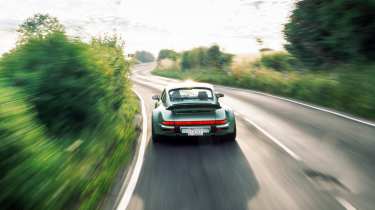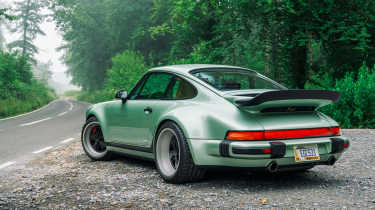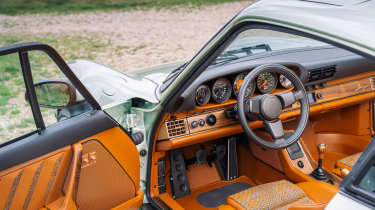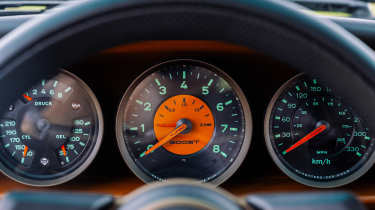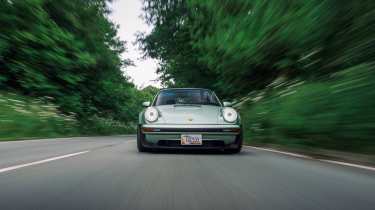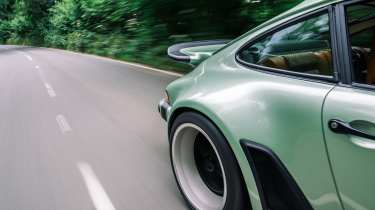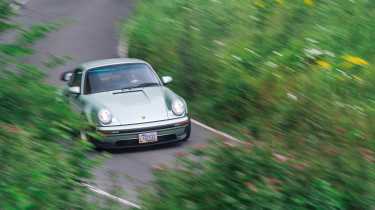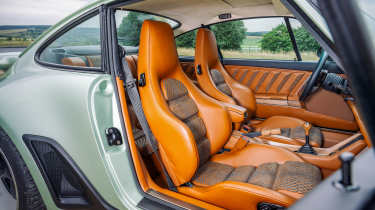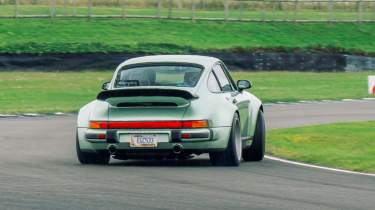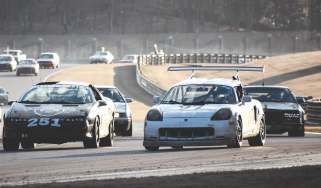Porsche 911 reimagined by Singer Classic Turbo 2024 review – the most complete restomod?
The 930 Turbo has remained somewhat off limits to the restomod scene, until now. Richard Meaden tests the Porsche 911 reimagined by Singer – Classic Turbo
Of all the 911’s many model derivatives, it’s hard to argue against the Porsche 911 Turbo being the most evocative. Yes, the RS remains the ultimate blend of race pedigree and road legality, but half a century on since Porsche first shoehorned a forced-induction flat-six into the tail of its rear-engined sports car, and long after the resulting model evolved into an all-wheel-drive, all-weather weapon, the merest mention of the Turbo name still conjures up images of whale tales, wide arches and an indecent appetite for the horizon.
Yes, Alois Ruf’s ‘Yellowbird’ took the early Turbo to wild extremes as far back as the ’80s, but for the continually evolving 21st-century Porsche 911 restomod scene, the 930 Turbo – indeed any generation of Turbo – has remained somewhat off limits.
Until now. It takes a lot – some would say a miracle – to have me set my alarm for 4.30am, especially on a Monday, but a rendezvous with the latest Porsche 911 Reimagined by Singer qualifies as ample motivation. In fact, I’m awake before the chimes of doom kick in, though this could be due to the anticipation of a Sausage & Egg McMuffin breakfast.
Before we get into the ins and outs of this Classic Turbo restoration it’s worth recapping the Singer backstory. Founded in 2009, Singer Vehicle Design started small with a big idea. Operating from somewhat ramshackle premises in one of the less salubrious neighbourhoods of Los Angeles, Rob Dickinson and a very small crew created a fastidious and extensive reimagining of the Porsche 911. One that would quickly come to define the restomod scene.
Fifteen years on much has changed, but the essence of what made Singer’s fledgling restoration business stand out is clearer than ever. Still inspired by an endless love and fascination for the 911 and driven by a compulsive urge to restore and enhance them to irresistible levels of quality and performance, the beautifully wrought and, yes, awkwardly named Porsche 911 Reimagined by Singer has become a true phenomenon.
More reviews
Group tests
In-depth reviews
Long term tests
Reviews
Back in the early days, Dickinson’s now famous ‘everything is important’ mantra was rattle-canned freehand onto the block wall of that original Sun Valley workshop. Now it is applied via laser-cut decal – suitably scaled up to fit the size of Singer’s huge US and UK facilities – as a mission statement for the 600-plus people who now count themselves as Singer employees.
The company’s trajectory seems almost too extraordinary to comprehend. Crucially, many of the original protagonists remain, including Dickinson as creative lead, and long-time business partner Mazen Fawaz, who is now the company’s CEO. Significant outside investment has brought serious financial clout. Enough to form a formidable senior management team, recruit skilled fabricators, body and paint specialists, trimmers, designers and engineers, engage leading technical partners including Bosch and Michelin, and operate from world-class facilities.
The monolithic buildings – including a vast new HQ in Torrance (part of LA’s South Bay region) and a growing UK campus in Northamptonshire – and the increasingly ambitious scope of the 911 restoration projects are impressive indicators of just how far things have come, but fittingly it is the cars that speak most eloquently.
The car you see here has been restored using what Singer describes as its Classic Turbo services. As for all of its projects, customers provide a 964-generation 911, which is then taken back to the bare bones before being reimagined. Rebodied in carbonfibre, painted to perfection, retrimmed in fabulous leathers and fabrics, and capability doubled with a finely tuned chassis and extensively optimised twin-turbocharged Mezger powertrain, the Classic Turbo services create a very different offering to what has gone before.
Dickinson and his design team have done a superb job of contemporising the 930 Turbo’s sacred signature look. Seen from a distance it has the same unmistakable physique as the original, but up close you appreciate that pretty much everything is different. Some iconic elements, such as the deeply dished Fuchs-style wheels and broad wheelarches, have been judiciously amplified, with ride height, camber angles and tyre stretch agonised over for the perfect stance. Then, just to confound the more-is-more crowd, other areas have been precisely pared back. The result is a design that’s both faithful and fresh.
Panel gaps and flushes are one of Dickinson’s (many) great obsessions. Rumour has it his right index finger has its own key person insurance, for this delicate digit is able to detect the slightest deviation from a level and uniform 4mm shut-line. There’s no arguing with the results of such obsessive detail freakery: the fit of this Palm Green Metallic car’s carbon panels is unerringly precise, with a paint finish that’s glass smooth and swimming-pool deep.
The black rubber and plastic pieces on the original 930 Turbo are a defining part of its overall look, and Singer’s contemporary take is just as effective, with a special soft-touch rubberised paint used to recreate the same look and similar finish on the hard carbonfibre bumpers, sills and aero parts. My favourite details are the serrated sections in the front and rear bumpers, which serve as knowing nods to the rubber bellows found in the 930’s impact bumpers. Oh, and the intake built into the ‘shark fin’ that protects the leading edge of the rear wheelarches.
It’s the same story inside. Singer’s commissioning process means they can indulge whatever the customer wishes. This particular example – fresh from the company’s display stand at Goodwood Festival of Speed – showcases a new vibe, with a far greater emphasis on comfort and the kind of luxe look that is very obviously inspired by 930s of the ’80s. The heavily sculpted seats are fabulous focal points, their blocky design affording generous cushioning and perfectly suiting the new woven riff on Porsche’s iconic Pascha upholstery. Rich and aromatic Cognac hide and inset fillets of dark, open-grained wood veneer set it off a treat.
It’s a fabulous place to find yourself. Mod cons such as hi-fi, satnav and MagSafe phone charging are unobtrusively integrated. The instrument cluster is bespoke, but blends the obvious finesse for which Singer is renowned with a restraint that lends it a period OE look. Touchpoints such as the organ-stop switches are original and unembellished, likewise the stalks and HVAC controls. The steering wheel is new, the Momo Prototipo found in Singer’s Classic restorations swapped for a wheel that’s redolent of the 930 Turbo’s. It’s another lovely slice of ’70s/’80s style and brings further completeness and maturity to this latest offering.
Twist the ignition key and the heavily reworked Mezger flat-six fires with a menacing flare of revs before settling into a meaty idle. Enlarged to 3746cc and featuring twin turbochargers with air-water intercooling, the engine has almost twice the power and torque of the original 1974 930 Turbo 3.0-litre unit. To spare you the maths, that’s a very healthy 510bhp and 442lb ft.
In line with Singer’s previous work, its Classic Turbo restorations are a kind of ‘greatest hits’ album, incorporating hardware and technology found in the full canon of 911 Turbos, right up to the current 992 Turbo S, plus some innovations of its own. When it comes to the engine this includes the all-important turbos. Supplied by Borg Warner they are the same type as those fitted to the 992 Turbo S, and feature both Variable Turbine Geometry and electric wastegates. Packaged in a bespoke Singer-specified turbine housing they give the Mezger unit unprecedented response at low rpm combined with serious shove at the top end.
The cylinder heads stick to the two-valves-per-cylinder design the company refined for its naturally aspirated Classic restorations, but with fresh attention paid to combustion temperatures in order to create a forced-induction engine that likes to rev yet keeps its cool. The result is a truly breathtaking crescendo at the top of each gear. Thanks to packaging the intercoolers in the engine plenum the rear wing is the slimmer whale tail of the early non-intercooled 930 Turbos as opposed to the bulkier and less visually pleasing ‘tea tray’ fitted to later intercooled models.
The crankshaft and conrods are manufactured by Austrian supplier Matzinger to Singer’s specification. The pistons and cylinders come in matched engine sets from legendary German maker Mahle, which also handles the management system. To cope with the engine’s greater potency a new gearbox with increased torque capacity was also commissioned. The six-speed H-pattern ’box has bespoke ratios chosen to complement the power and torque curves of the turbocharged engine. The gears are wider and of increased diameter to cope with the torque, with meatier triple-cone carbon synchros to give smooth shifts.
There is a choice of cast-iron or carbon-ceramic brakes (this car has been fitted with the former set-up) that sit perfectly within those 18-inch Fuchs-style rims that are of the same dimensions as those made for Singer’s DLS restorations. Here they are fitted with Michelin Pilot Sport 4 S tyres – 245/35 front and 295/30 at the rear – rather than Cup 2s, as this is a GT car aimed squarely at road use, albeit with a modicum of track capability.
The first few miles behind the wheel are spent soaking it all in. Those characteristic wide arches mean the car fills more of the road, but still the 964’s dimensions and cockpit design bring welcome intimacy and proximity to the action. The shallow dash and upright windscreen frame a timeless driver’s-eye view familiar to 911 pilots since the earliest days, the long, barrel-topped front arches providing you with perfect reference points with which to place the inside-front wheel bang on your chosen apex.
The steering is weighty, with the kind of delicious viscosity that only comes with hydraulic power assistance. It’s not as clean and filtered as a modern EPAS system, but what you lose in clarity and unerring consistency you gain in texture and being party to the quiet conversation that babbles through the steering wheel as the front tyres interact with the surface. It’s a trait lost to modern 911s, but very much present and correct here.
This subtle engagement sets the tone for what is a very grown-up driving experience, one that effortlessly moulds to your mood and works with whatever road you find yourself on. As you’d hope, the turbocharged engine brings a big lift in performance, but it serves to expand the whole experience rather than simply punch you harder down the road.
Initially this manifests as grin-inducing in-gear flex through the low-and mid-range. It’s a quality that has defined 911 Turbos throughout the ages and something that makes this car both immensely impressive and completely addictive. Those trick turbochargers mean there’s an immediate swell of propulsion when you squeeze into the throttle, so for the most part you can use this early surge to carry you down the road without truly extending the engine.
It’s possible to detect aspects from most generations of Turbo in the way this car makes progress. It’s more guttural than the earliest Turbos – and much faster – but there are clear hints of the 964 and 993 (the first to feature twin turbos and all-wheel drive) in its delivery and demeanour. Overlay with the scope of a 997, the rear-drive balance of a GT2 and the throttle response of a 992 and you’ve got the picture. It’s a heady brew.
Ride-wise, first impressions are of a firmly suspended car, but there’s terrific control combined with compliance to take the sting out of the UK’s rougher roads. It’s certainly less combative than a 992. Credit to those who have tuned the passive two-way adjustable R53 dampers, which bring a feeling of free-flowing support without the stiction that can make sporting suspension set-ups feel jagged and abrupt when transitioning between bump and rebound strokes.
You might expect an adaptive damper on a car at this price point, but there’s something rather nice about a car that strikes a hard-won balance of ride and handling that commits to compromises that feel appropriate to the car. Yes, there are occasions when you might want a bit more low-speed pliancy, but the overall experience is very satisfying – largely because you’re not fiddling with different suspension modes, so you learn to understand the car that’s beneath you and form a more genuine bond as a result.
On the twistier and more confined sections of West Sussex lanes this 911 is both eminently placeable and brilliantly exploitable. There’s lots of grip and traction – far more than you’d expect from a 964-based car – but it has that malleable feel that involves you well before the limit of the chassis or tyre. This is partly down to having such plentiful shove between the corners, but also because the car is light (around 1280kg) and – most importantly – because it feels much more like a 911 than the latest-gen cars, thanks to rear-wheel drive, a manual transmission and a palpable rearward weight bias that brings the whole car to life without it feeling remotely unstable.
If you’re new to older-generation 911s it will initially seem a little alien, but the way you can use that unique weight bias to adjust the cornering attitude will soon feel like a revelation. Fine adjustments can be made with small shifts in throttle input, a fractional lift as you turn in just enough to inject a little more rotational energy into the car without upsetting it in the slightest. More deliberate lifts have stronger effects (we’ll get to the skids in a minute), but such is the underlying grip reserve you find there’s always plenty to lean on.
Aiding this exploitability is a suite of electronic driver aids that bring this late ’80s/early ’90s platform bang up to date. Developed with Bosch, the state-of-the-art, driver-selectable vehicle dynamics control system optimises ABS, stability control and traction control via five drive modes: Weather, Normal, Sport, Track and ESC Off. Sensibly there’s no change in engine power or throttle response, so the potency of the car remains consistent throughout, but the level of sensitivity and intervention thresholds for the systems are tailored. Sport is the sweetest setting for general road driving in dry conditions, allowing as much yaw and wheel slip as you would sensibly want on the road while still offering enough support to catch the car before things get too lairy.
Track and ESC Off are where things get serious. The former relaxes the ESC and TC enough that you can really hustle at circuit speeds, and brake hard and deep thanks to an increased ABS threshold. ESC Off maintains ABS at the Track level but removes all TC and ESC intervention, so you are in complete control of your own destiny. Or to blame for any grassy excursions.
On a dry surface, it takes a concerted effort to get the car significantly sideways through Goodwood’s Lavant corner. Your head might tell you it’s a second-gear effort, but such is the torque on tap you can power it all the way through in third if you’re prepared to work it hard enough on the way in and then give it enough throttle to overcome the abundant grip to sustain the slide. Not something you’ll be doing on the road, granted, but a clear indication that this car has been developed and set up by people who know how a great 911 should feel at and beyond its limit. Most importantly of all it has that Turbo trait of sucking in the road like a strand of spaghetti.
With this latest restoration, Singer has introduced new-found maturity and whole-car sophistication. Adding turbocharging has brought a welcome and highly addictive uplift in performance, along with a seductive shift in character. It’s hard not to fall for a manual, rear-drive, air-cooled, 500-plus bhp Porsche 911, yet it’s the integrity, completeness and authenticity of the overall transformation that leaves the most lasting impression. Even by Singer standards it truly is the most gorgeous of things.
Of course, we should expect nothing less from a restoration that requires commissioning customers to commit upwards of £850,000 (plus taxes). That’s a heap of money to lavish on any car, but the result is a meticulously hand-crafted 911 that honours the Turbo in the best possible way.
| Engine | Flat-six, 3746cc, twin-turbo |
|---|---|
| Power | 510bhp @ 6500rpm |
| Torque | 442lb ft @ 2500-5500rpm |
| Weight | c1280kg (depending on specification) |
| Power-to-weight | c405bhp/ton |
| Tyres | Michelin Pilot Sport 4S |
| 0-62mph | N/A |
| Top speed | N/A |
| Typical price | $1.1m (c£853,000) plus local taxes and donor car |


